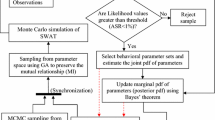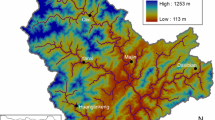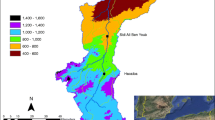Abstract
The quantification of uncertainty in the simulations from complex physically based distributed hydrologic models is important for developing reliable applications. The generalized likelihood uncertainty estimation method (GLUE) is one of the most commonly used methods in the field of hydrology. The GLUE helps reduce the parametric uncertainty by deriving the probability distribution function of parameters, and help analyze the uncertainty in model output. In the GLUE, the uncertainty of model output is analyzed through Monte Carlo simulations, which require large number of model runs. This induces high computational demand for the GLUE to characterize multi-dimensional parameter space, especially in the case of complex hydrologic models with large number of parameters. While there are a lot of variants of GLUE that derive the probability distribution of parameters, none of them have addressed the computational requirement in the analysis. A method to reduce such computational requirement for GLUE is proposed in this study. It is envisaged that conditional sampling, while generating ensembles for the GLUE, can help reduce the number of model simulations. The mutual relationship between the parameters was used for conditional sampling in this study. The method is illustrated using a case study of Soil and Water Assessment Tool (SWAT) model on a watershed in the USA. The number of simulations required for the uncertainty analysis was reduced by 90 % in the proposed method compared to existing methods. The proposed method also resulted in an uncertainty reduction in terms of reduced average band width and high containing ratio.








Similar content being viewed by others
References
Arabi M, Govindaraju RS, Engel B, Hantush M (2007) Multiobjective sensitivity analysis of sediment and nitrogen processes with a watershed model. Water Resour Res 43(6):W06409. doi:10.1029/2006WR005463
Arnold JG, Srinivasan R, Muttiah RS, Williams JR (1998) Large area hydrologic modeling assessment: part I model development. J Am Water Resour Assoc 34(1):73–89
Athira P, Sudheer KP, Cibin R, Chaubey I (2011) Sensitivity analysis of stream flow generation parameters of SWAT model. Paper presented at the annual conference of the ASABE, Louisville, KY, paper No. 1111731
Beven KJ (1989) Changing ideas in hydrology: a case of physically based models. J Hydrol 105:157–172
Beven KJ (2000) On the future of distributed modeling in hydrology. Hydrol Process 14(16–17):3183–3184
Beven KJ (2006) A manifesto for the equifinality thesis. J Hydrol 320:18–36
Beven KJ, Binley AM (1992) The future of distributed models: model calibration and uncertainty prediction. Hydrol. Process 6:279–298. doi:10.1002/hyp.3360060305
Beven K, Freer J (2001) Equifinality, data assimilation, and uncertainty estimation in mechanistic modelling of complex environmental systems using the glue methodology. J Hydrol 249(14):11–29
Blasone RS, Madsen H, Rosbjerg D (2008a) Uncertainty assessment of integrated distributed hydrological models using GLUE with Markov chain Monte Carlo sampling. J Hydrol 353:18–32
Blasone RS, Vrugt JA, Madsen H, Rosbjerg D, Robinson BA, Zyvoloski GA (2008b) Generalized likelihood uncertainty estimation (GLUE) using adaptive Markov Chain Monte Carlo sampling. Adv Water Resour 31:630–648
Brigode P, Oudin L, Perrin C (2013) Hydrological model parameter instability: a source of additional uncertainty in estimating the hydrological impacts of climate change? J Hydrol 476:410–425. doi:10.1016/j.jhydrol.2012.11.012
Carota C, Parmigiani G, Polson NG (1996) Diagnostic measures for model criticism. J Am Statist Assoc 91:753–762
Chen J, Wu Y (2012) Advancing representation of hydrologic processes in the soil and water assessment tool (SWAT) through integration of the topographic model (TOPMODEL) features. J Hydrol 420–421:319–328
Cibin R, Sudheer KP, Chaubey I (2010) Sensitivity and dentifiability of stream flow generation parameters of the SWAT model. Hydrol Process 24(9):1133–1148
Cibin R, Athira P, Sudheer KP, Chaubey I (2014) Application of distributed hydrological models for predictions in ungauged basins: a method to quantify predictive uncertainty. Hydrol Process. doi:10.1002/hyp.9721
Deb K, Pratap A, Agarwal S, Meyarivan T (2002) A fast and elitist multiobjective genetic algorithm: NSGA-II. IEEE Trans Evol Comput 6:182–197
Demaria EM, Njissen B, Wagener T (2007) Monte Carlo sensitivity analysis of land surface parameters using the variable infiltration capacity model. J Geophys Res 112:D11113
Doherty J (2004) PEST model—independent parameter estimation. Watermark Numerical Computing, Brisbane
Duan Q, Sorooshian S, Gupta VK (1992) Effective and efficient global optimization for conceptual rainfall-runoff models. Water Resour Res 28(4):1015–1031
Freer J, Beven KJ, Ambroise B (1996) Bayesian estimation of uncertainty in runoff prediction and the value of data: an application of the GLUE approach. Water Resour Res 32(7):2161–2173
Gardner RH, O’Neill RV (1983) Parameter uncertainty and model predictions: a review of Monte Carlo results. In: Berk MB, Straten GV (eds) Uncertainty and forecasting of water quality. Springer, New York, pp 245–257
Gassman PW, Reyes MR, Geen CH, Arnold JG (2007) The soil and water assessment tool: historical development, applications and future research directions. Trans ASABE 50(4):1211–1250
Hughes DA (2010) Hydrological models: mathematics or science? Hydrol Proces 24:2901–2201
Jia Y, Culver TB (2008) Uncertainty analysis for watershed modeling using generalized likelihood uncertainty estimation with multiple calibration measures. J Water Resour Plan Manage 134(2):97–106
Jin X, Chong-Yu Xu, Zhang Q, Singh VP (2010) Parameter and modeling uncertainty simulated by GLUE and a formal Bayesian method for a conceptual hydrological model. J Hydrol 383:147–155
Katz RW (2002) Techniques for estimating uncertainty in climate change scenarios and impact studies. Climate Res 20:167–185
Kuczera G, Parent E (1998) Monte Carlo assessment of parameter uncertainty catchment models: the Metropolis algorithm. J Hydrol 211:69–85
Kullback S (1959) Information theory and statistics. Wiley, New York
Li L, Xia J, Xu C-Y, Singh VP (2010) Evaluation of the subjective factors of the GLUE method and comparison with the formal Bayesian method in uncertainty assessment of hydrological models. J Hydrol 320:132–154
MacKay DJC (2003) Information theory, inference, and learning algorithms. Cambridge University Press, Cambridge (ISBN 0-521-64298-1)
Manache G, Melching CS (2008) Identification of reliable regression- and correlation-based sensitivity measures for importance ranking of water-quality model parameters. Environ Model Softw 23:549–562
Migliaccio KW, Chaubey I (2008) Spatial distributions and stochastic parameter influences on SWAT flow and sediment predictions. J Hydrol Eng 13(4):258–269
Neitsch SL, Arnold JG, Kiniry JR, Williams JR, King KW (2002) Soil water assessment tool theoretical documentation. Version 2000. Texas Water Resource Institute, College Station, Texas. TWRI Report, TR-191
Rastetter EB, King AW, Cosby BJ, Hornberger GM, O’Neill RV, Hobbie JE (1992) Aggregating fine-scale ecological knowledge to model coarser-scale attributes of ecosystems. Ecol Appl 2:55–70
Razavi S, Tolson BA (2013) An efficient framework for hydrologic model calibration on long data periods. Water Resour Res 49:8418–8431. doi:10.1002/2012WR013442
Refsgaard JC, Sluijs JP, Hojberg AL, Vanrolleghem PA (2007) Uncertainty in the environmental modeling process—a framework and guidance. Environ Model Softw 22:1543–1556
Renard B, Kavetski D, Kuczera G, Thyer M, Franks SW (2010) Understanding predictive uncertaintyin hydrologic modeling: the challenge of identifying input and structural errors. Water Resour Res 46:W05521. doi:10.1029/2009WR008328
Shafii M,Tolson B, Matott LS (2014) Uncertainty based multi-criteria calibration of rainfall-runoff models: a comparative study. Stochast Environ Res Risk Assess. doi:10.1007/s00477-014-0855-x
Shen ZY, Chen L, Chen T (2012) The influence of parameter distribution uncertainty on hydrological and sediment modeling: a case study of SWAT model applied to the Daning watershed of the three gorges reservoir region, China. Stochast Environ Res Risk Assess. doi:10.1007/s00477-012-0579-8
Smith PJ, Tawn J, Beven KJ (2008) Informal likelihood measures in model assessment: theoretic development and investigation. Adv Water Resour. doi:10.1016/j.advwatres.2008.04.012
Sobol IM (1993) Sensitivity estimates for nonlinear mathematical models. Math Model Comput Exp 1:404–414
Srivastav RK, Sudheer KP, Chaubey I (2007) A simplified approach to quantify predictive and parametric uncertainty in artificial neural network hydrologic models. Water Resour Res 43(10) (Art. No. W10407). doi:10.1029/2006WR005352
Stedinger JR,Vogel RM, Lee SU, Batchelder R (2008) Appraisal of the generalized likelihood uncertainty estimation (GLUE) method. Water Resour Res 44. doi:10.1029/2008WR006822
Tourassi GD, Frederick ED, Markey MK, Carey E, Floyd J (2001) Application of the mutual information criterion for feature selection in computer-aided diagnosis. Med Phys 28:2394–2402
Vrugt JA, Gupta HV, Bouten W, Sorooshian S (2003) A shuffled complex evolution metropolis algorithm for optimization and uncertainty assessment of hydrologic model parameters. Water Resour Res 39(8):1201. doi:10.1029/2002WR001642
Vrugt JA, ter Braak CJF, Gupta HV, Robinson BA (2009) Equifinality of formal (DREAM) and informal (GLUE) Bayesian approaches in hydrologic modeling? Stoch Env Res Risk Assess 23(7):1011–1026. doi:10.1007/s00477-008-0274-y
Wang G, Xia J, Chen J (2009) Quantification of effects of climate variations and human activities on runoff by a monthly water balance model: a case study of the Chaobai river basin in northern China. Water Resour Res 45:W00A11. doi:10.1029/2007WR006768
Wiwatenadate P, Claycamp HG (2000) Error propagation of uncertainties in multiplicative models. Human Ecol Risk Assess 6:355–368
Wu Y, Liu S (2012) Automating calibration, sensitivity and uncertainty analysis of complex models using the R package flexible modeling environment (FME): SWAT as an example. Environ Model Softw 31:99–109
Wu Y, Liu S (2014) Improvement of the R-SWAT-FME framework to support multiple variables and multi-objective functions. Sci Total Environ 466–467:455–466
Xiong LH, Wan M, Wei XJ, O’Connor KM (2009) Indices for assessing the prediction bounds of hydrological models and application by generalised likelihood uncertainty estimation. Hydrol Sci J (J Sci Hydrologiques) 54(5):852–871
Yang J, Reichert P, Abbaspour KC, Xia J, Yang H (2008) Comparing uncertainty analysis techniques for a SWAT application to the Chaohe basin in China. J Hydrol 358:1–23
Zitzler E, Laumanns M, Thiele L (2001) SPEA2: improving the performance of the strength Pareto evolutionary algorithm. Tech. Report 103. Zurich, Switzerland: Swiss Federal Institute of Technology (ETH), Computer Engineering and Communication Networks Lab (TIK)
Author information
Authors and Affiliations
Corresponding author
Rights and permissions
About this article
Cite this article
Athira, P., Sudheer, K.P. A method to reduce the computational requirement while assessing uncertainty of complex hydrological models. Stoch Environ Res Risk Assess 29, 847–859 (2015). https://doi.org/10.1007/s00477-014-0958-4
Published:
Issue Date:
DOI: https://doi.org/10.1007/s00477-014-0958-4




